|
I summited
Everest on May 21, 2011 and have climbed it three other
times (all from Nepal) - 2002, 2003 and 2008 each
time reaching just below the Balcony around 27,500'
(8400 meters) before health, weather or my own judgment caused
me to turn back. I attempted Lhotse twice
- 2015 and 2016. When not climbing, I cover the Everest season
from my home in Colorado as I did for the 2004, 2005, 2006, 2007, 2009, 2010, 2012, 2013, 2014, 2015, 2016 , 2017, 2018, 2019,
a virtual 2020 season, 2021, 2022, 2023 and
now the 2024
season.
This page is an overview of Everest climbs and an index
for the other pages with more information on routes, pictures, essays,
trip reports and more.
|
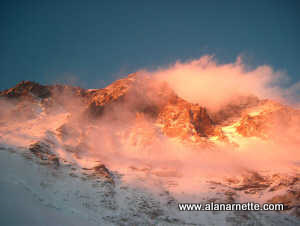 Mt.
Everest is the most famous mountain in the world. Drawing climbers
for almost a century, it is know as Chomolungma Peak in Tibet and
Mount Sagarmatha in Nepal. Mt.
Everest is the most famous mountain in the world. Drawing climbers
for almost a century, it is know as Chomolungma Peak in Tibet and
Mount Sagarmatha in Nepal.
The north side was first attempted by a British team
in 1922. They reached 27,300' before turning back. The 1924 British
expedition with George Mallory and Andrew Irvine was notable for
the mystery of whether they summited or not. Mallory's body was
found in 1999 but there was no proof that he died going up or coming
down. It was a Chinese team who made the first summit from Tibet
on May 25, 1960 by Nawang Gombu (Tibetan) and Chinese Chu Yin-Hau
and Wang Fu-zhou who is said to have climbed the Second Step in
his sock feet.
However, the first summit of Mt. Everest was by Sherpa
Tenzing Norgay and New Zealander Edmund Hillary with a British
expedition in 1953. They took the South Col route which is used
by the majority of modern expeditions. At that time the route had
only been attempted twice by Swiss teams in the spring and autumn
of 1952. They reached 8500m well above the South Col. Of note,
Norgay was with the Swiss thus giving him the experience he used
on the British expedition. The Swiss returned in 1956 to make the
second summit of Everest.
Today, hundreds of climbers from around world try
to stand on top of the world.
Statistics Updated through January 2024
The Himalayan Database reports that through January 2024, there
have been 11,996 summits (5,899 members and 6,097 hired) on Everest
by all routes by 6,664 different people. Those climbers who have
summited multiple times include 1,571 members and 1,048 Sherpa,
for 5,333 total summits. There have been 883 summits by women members.
Summits
The Nepal side is more popular, with 8,350 summits compared to
3,646 summits from the Tibet side. Only 1.9% or 224 climbers
summited without supplemental oxygen. Only 35 climbers have traversed
from one side to the other. Member summit success stands at 39%,
with 5,899 who attempted to summit, making it out of 14,496 who
tried. About 62% of all expeditions put at least one member on
the summit. Few climbers from both Nepal and Tibet have summited,
only 668. And even fewer, 155, have summited more than once in
a single season. Almost only Sherpas, 78, have summited within
seven days of their first summit that season. Kami Rita Sherpa
(Thami) holds the record for most summits at 29 and Kenton Cool,
UK, at 17 for a non-Sherpa. Seven Sherpa have 20 or more summits.
Member climbers from the USA have the most country member summits
at 906.
Deaths
As for Everest deaths, 327 people (199 Westerners and 110 Sherpas)
died from 1922 to January 2024. These deaths are about 2.7% of
those who summited for a death rate of 1.11 of those who attempted
to make the summit. Westerners die at a higher rate, 1.38, compared
to hired at 0.87. Descending from the summit bid is deadly, with
92 deaths, or 28% of the total deaths. Female climbers have a
lower death rate at 0.81 compared to 1.14 for male climbers,
and 14 women have died on Everest. The Nepal side has seen 217
deaths or 2.8%, a rate of 1.14. The Tibet side has experienced
110 deaths or 3%, a rate of 1.09. Climbers from the UK and Japan
have the most all-time deaths at 17. Most bodies are still on
the mountain, but China has removed many bodies from sight on
their side. The top causes of death are avalanches (77), falls
(75), altitude sickness (45), and exposure (26).
Latest: Spring 2023
In 2023, there were 667 summits, including only 12 from Tibet as
it was closed to foreigners but 665 from Nepal, and all but 3
used supplemental oxygen. There were a record 18 deaths of Everest
climbers. 57% of all attempts by members were successful. Of
the total, 61 females summited.
Everest compared to Other 8000ers
Everest is becoming safer even though more people are now climbing.
From 1923 to 1999, 170 people died on Everest with 1,170 summits
or 14.5%. But the deaths drastically declined from 2000 to 2023,
with 10,826 summits and 157 deaths or 1.4%. However, four years
skewed the death rates, with 17 in 2014, 14 in 2015, 11 in 2019,
and the record 18 in 2023. The reduction in deaths is primarily
due to better significantly higher Sherpa support ratios, improved
supplemental oxygen at higher flow rates (up to 8 lpm) gear,
weather forecasting, and more people climbing with commercial
operations.
Of the 8000-meter peaks, Everest has the highest absolute number
of deaths (member and hired) at 327 but ranks near the bottom with
a death rate of 1.11. Annapurna is the most deadly 8000er, with
one death for about every fifteen summits (73:476) or a 3.76 death
rate. Cho Oyu is the safest, with 4,044 summits and 52 deaths or
a death rate of 0.40, with Lhotse next at 0.38. Of note, 79 Everest
member climbers out of 200 members deaths died descending from
the summit, or 39%. K2's death rate has fallen dramatically from
the historic 1:4 to around 1:8, primarily due to more commercial
expeditions with huge Sherpa support ratios.
You are about to spend $10,000 or even $50,000 to climb the
mountain of your dreams but are you ready? Summit
Coach's consulting service can help climbers of
all experience levels better prepare and increase their chances
of a positive expedition. Based on Alan Arnette’s 23
years of high altitude mountain experience and 30 years as
a business executive, we help aspiring climbers throughout
the world achieve their goals through a personalized set of
consulting services.
The menu at the top of each Everest page
links to:
- Pictures from
the climbs are organized in six albums by the trek in, base camp,
Khumbu Icefall, Lhotse Face, South Col and Above and a Best of
Everest Album.
- Videos from my Everest
climbs.
- Alan's Khumbu Trek, 2002, 2003, 2008 and 2011 summit Climbs with
an overview and dispatches sent during the climbs
- Coverage and commentary for the 2004, 2005, 2006, 2007, 2009, 2010, 2012, 2013, 2014, 2015, 2016 , 2017, 2018, 2019,
a virtual 2020 season, 2021, 2022, 2023 and
now the 2024 season.
- 6 essays on topics from money to family to death
- Extras including Everest
for Kids, Musical
Slide Show and Pictures of the South
Col Route plus the Northeast
Ridge Route map and Communications
from Everest
- Frequently Asked Questions (FAQ)about
climbing Mt. Everest, Khumbu
Trek and 8000m
climbs
|
Everest 2002 Climb
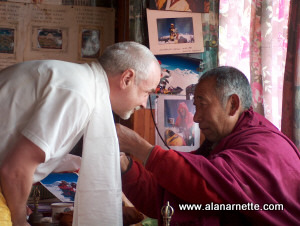
In 2002 I attempted Everest using the Southeast ridge route. This
was my most difficult climb thus far due to the length of the
trip, logistics and health. I reached 27,200' (8250m), a personal
record, before turning back just below the balcony due to a lung
infection. It was a fabulous trip that I never anticipated making
when I starting climbing seven years earlier.
There were 155 summits in 2002 with 2 deaths.
Continue reading about the Everest 2002
climb.
|
Everest 2003 Climb
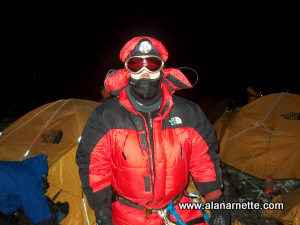
I returned to Everest in 2003, to attempt the South side again.
While it was incredible to be back only ten months after my 2002
climb, it was a big disappointment with altitude sickness and
weather problems. I knew about halfway through I would not summit
so I reset my goal to go as high as I could - safely - and reached
27,200' (8250m), the exact same spot as 2002.
There were 267 summits in 2003 with 4 deaths.
Continue reading about the Everest 2003
climb.
|
Everest 2004 Coverage
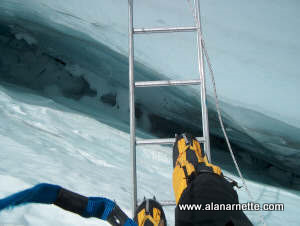
Over 337 climbers reached the summit on all routes, 99 on May 16
and 17 alone!. 169 summiteers were clients, 169 guides and Sherpas.
There were 7 deaths. By far, Sherpas have summited Everest more
than any other category of climber. The most sought out Sherpas
have summited 5 or more times and know the routes, conditions
and how to deal with Westerners.
Continue reading about Everest in 2004 |
Everest 2005 Coverage
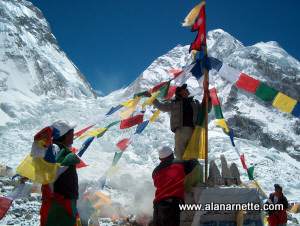
Quite a season! The summits on May 21 were the latest first summit
day in 45 years of climbing Mt. Everest. Norgay and Hillary did
it on May 29, the earliest was April 4 in 1984. But it was still
a good year for summits with 307 climbers standing on the top of
the world. Sadly there were 6 deaths.
The season started quickly with teams arriving early and getting
their acclimation trips in by early May. They were assuming a "normal" season
with first summits around May 15. But the Jet just sat there. It
didn't move and when it did, it came back so quickly that the 3-day
window never materialized. So the climbers sat in base camps. Some
went down valley to enjoy the rich air and sleep on real beds,
some went on sight seeing trips to nearby Monasteries and other
just sat there. But they entertained themselves with chess games,
concerts, hockey games and swap meets. These climbers are creative
if nothing else!
Continue reading about Everest in 2005
|
Everest 2006 Coverage
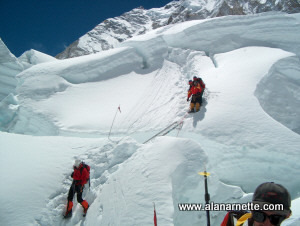
The season started with controversy as the political unrest in
Katmandu delayed many expeditions and created uncertainty that
gear and climbers would arrive on time. However it all got sorted
as seasoned leaders guided their teams through the bureaucracy,
small arms fire and chaos that comes with a country in turmoil.
But by early April base camp on both sides were established and
teams got settled in. However there was a huge surprise for this
season! The weather was spectacular and teams on the north took
advantage of it by aggressively fixing the ropes to the summit
(and beyond!).
It was a record year for summits with 479 reaching the top from
both sides but there was also 11 deaths, the most since 1996.
Continue reading about Everest in 2006
|
Everest 2007 Coverage
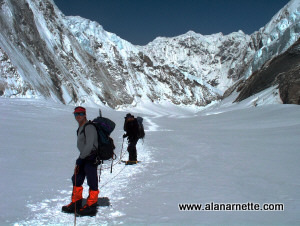
The season started early - late March - with the arrival of the
huge IMG team closely followed by the Xtreme Everest Medical
expedition into Nepal. Over on the north it seemed that Hollywood
had moved to Tibet for April and May.
Dispatch after dispatch spoke of their "film crew" and
some climbers were worried about their bad hair days. But one climber
stood out - David Tait. The British climber was on a mission to
raise money for his charity by attempting the never before accomplished
double traverse. He began posting his thoughts, fears and observation
in a rarely seen candid manner.
It was another record year for summits with 632 reaching the top
from both sides but there was also 7 deaths.
Continue reading about Everest in 2007
|
Everest 2008 Climb
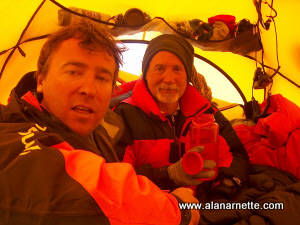
I returned to Everest in 2008, to attempt the South side again
as part of The Road
Back to Mt. Everest . I had trained hard with four previous
high altitude climbs in the prior 8 months. I felt great the
majority of the climb but felt it was too dangerous for me to
continue and turned back at the Balcony or 27,500' (8300m) which
was 1535 ' short of the highest point on earth. This was my highest
altitude ever reached.
I have written an extensive document on the experiences during
this climb as impacted by the Chinese Olympic torch summit and
closure of the north and heavy restrictions on the south side.
It is a PDF document named Everest
2008: Mountain of Politics
426 people summited in 2008 with only 1 death.
Continue reading about the Everest 2008
climb
|
Everest 2009 Coverage
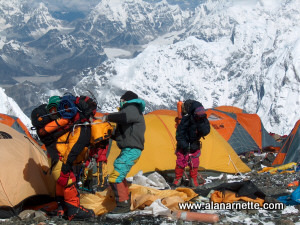
Overall this was one of the safest seasons in the past few years
in spite of some difficult weather that created a long delay
in early May. There were over 400 summits and sadly 5 deaths
on Everest and one on Lhotse.
Similar to 2008, the Chinese Tibet Mountaineering Association
(CTMA) changed the rules and gave vague guidance to teams during
the critical planning period resulting in almost all of the major
north side operators making the switch to Nepal. That fueled speculation
of overcrowding, bottlenecks and record summits and record deaths.
And in the end it was just speculation.
462 summits and 5 deaths.
Continue reading about Everest in 2009
|
Everest 2010 Coverage
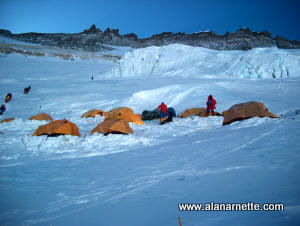
By recent standards, Everest 2010 was a safe and successful year.
There were about 537 summits (347 from the south) with 3 reported
deaths, all on the north, and several injuries and rescues. The
total Everest summits broke the 5,000 level since 1953.
This year's story line for climbers and their families was the
weather, however it was all Jordan Romero and Apa Sherpa for the
rest of the world.
For the first time in several years, the north operated in an
almost normal manner. Teams dealt with a few border restrictions
early but arrived at base camp and immediately began their acclimatization
rotations.
On the South, the ropes were in early and the weather seemed
drastically different from the North, at least in April.
Continue
reading about Everest in 2010 |
Everest
2011 Summit
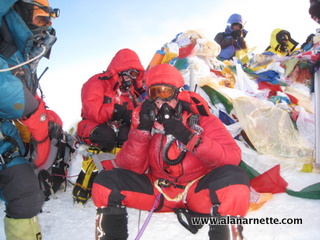
I summited Everest on May 21, 2011 from the Nepal side in 2011
with International Mountain Guides. This was part of The
7 Summits Climb for Alzheimer's: Memories are Everything® campaign.
It was very humbling standing on the summit after all my attempts
but more gratifying was the reaction to my Alzheimer's awareness
and fund raising efforts. Thank you everyone who participated.
I approached this climb quite differently from previous attempts
including preparation, to training to guide service and more.
The Himalayan database states there were 537combined summits from
both sides 58% summit to climbers at base camp. 375 summited from
Nepal and 162 from Tibet. 4 deaths.
Read the live updates
from Everest 2011 |
Everest 2012 Coverage
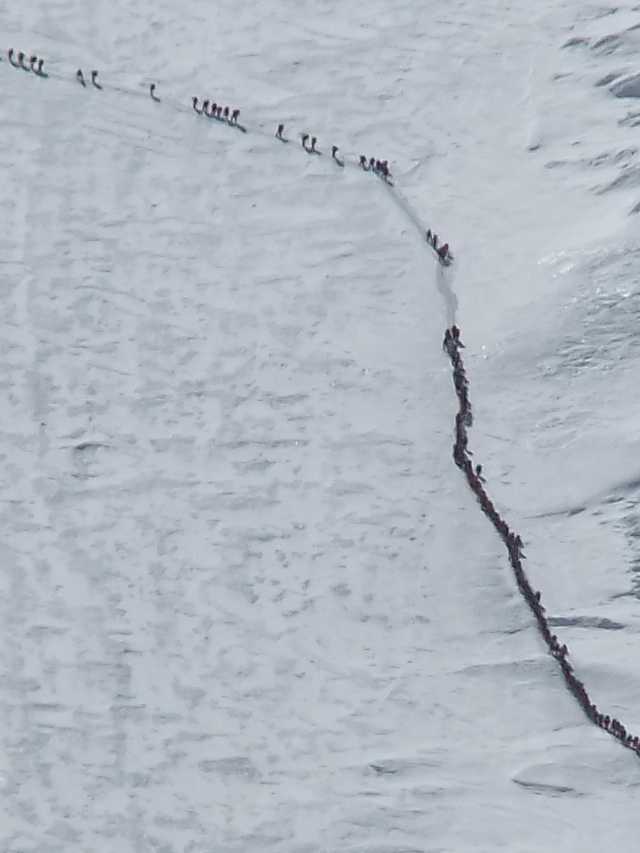
Perhaps the most dramatic year since 1996. A lack of snow combined
with high winds created dangerous rock fall on the Lhotse Face
causing many injures primarily to Sherpas before the route was
moved to a safer passage to Camp 3.
However, these dangers plus the deaths of three Sherpas early
in April from multiple causes, caused the Sherpas from Himex to
lose confidence. Russell Brice, arguably the most famous of the
Everest commercial operators, cancelled his entire Himalayan spring
season (Everest, Lhotse and Nuptse) taking over 100 people off
the mountain. It was an unprecedented decision.
The other teams continued fighting difficult weather on both sides
of Everest and with only four days of suitable weather for summit
pushes endured the famous crowds at the normal bottle necks of
the 2nd Step, and the Hilary Step. Totally unrelated to the crowds,
weather or rock fall, 6 more climbers died primarily from poor
decision making or altitude related illnesses generating sensational
headlines around the world and calls for regulation on Everest.
There were 558 summits in the Spring of 2012, 441 on the south
and 147 on the north. 10 confirmed deaths.
Continue
reading about Everest in 2012 |
Everest 2013 Coverage
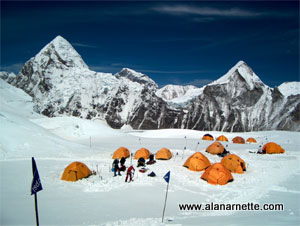
Everest 2013 was a good year for most climbers but a difficult
one for the professionals. Overall it could be termed a normal
year with little drama with one large exception.
There were 670 summits in the Spring of 2013, 541 on the south
and 124 on the north. 8 confirmed deaths.
For many climbers, they accomplished a life long dream, returned
safely home to a family who have started to breath again. With
an unparalleled lifetime experience, for some their lives were
changed forever.
Continue
reading about Everest 2013
|
Everest 2014 Coverage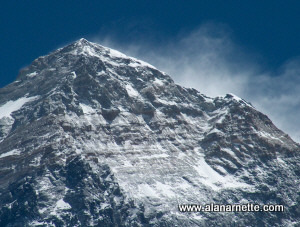
The The Everest 2014 season was full of tragedy with 19 deaths,
shameful exploitation and thin coverage of the real story by the
general media. In my season summary, I look at what happened, the
reasons for effectively closing Everest from Nepal, the roles played
by all parties and some ideas on a credible path forward.
The summary is not a sound bite, it is long, complicated and will
take time to digest. Just like anything with Everest it will evoke
emotions and reactions. My hope is for badly needed changes on
Everest. A mountain I value and whose climbers I admire - past,
present and future.
There were 124 summits from the North and 4 from the South which
were disputed as the climbers took helicopters to and from Cam
2. There were 17 deaths from an avalanche off the West Shoulder
of Everest onto the Khumbu Ice fall.
Continue
reading about Everest 2014 |
Everest 2015 Coverage
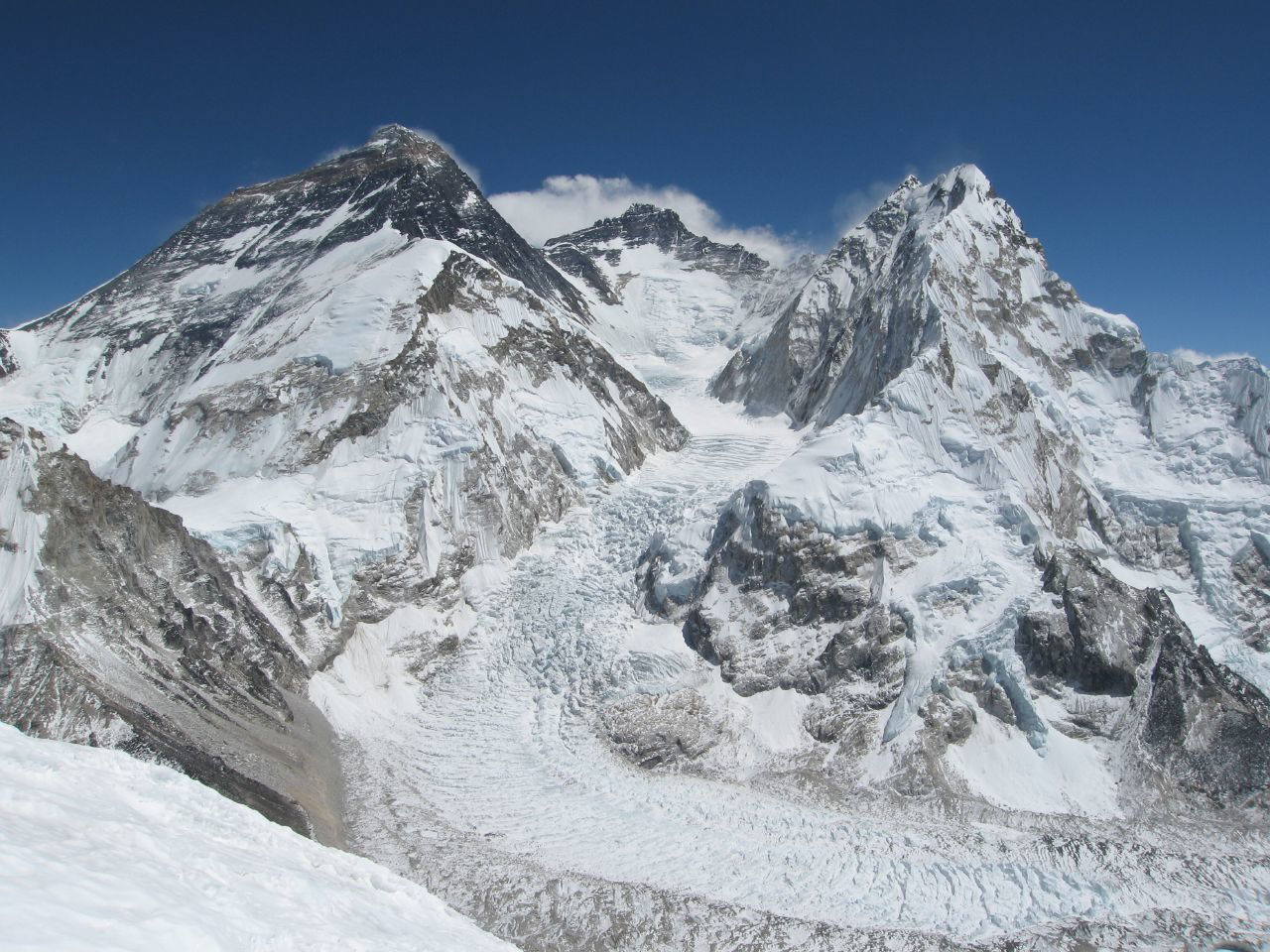
Another tragic season but this time due to an earthquake,
not climbing events. 19 people were killed at Everest Base camp
then the Chinese closed the North fearing aftershocks. Nepal continued
to promote climbing but no team wanted to risk going back through
the Icefall.
For the first time since 1974, there were no Spring
summits on Everest from any route, any camp by any means.
Continue
reading about Everest 2015
|
Everest 2016 Coverage
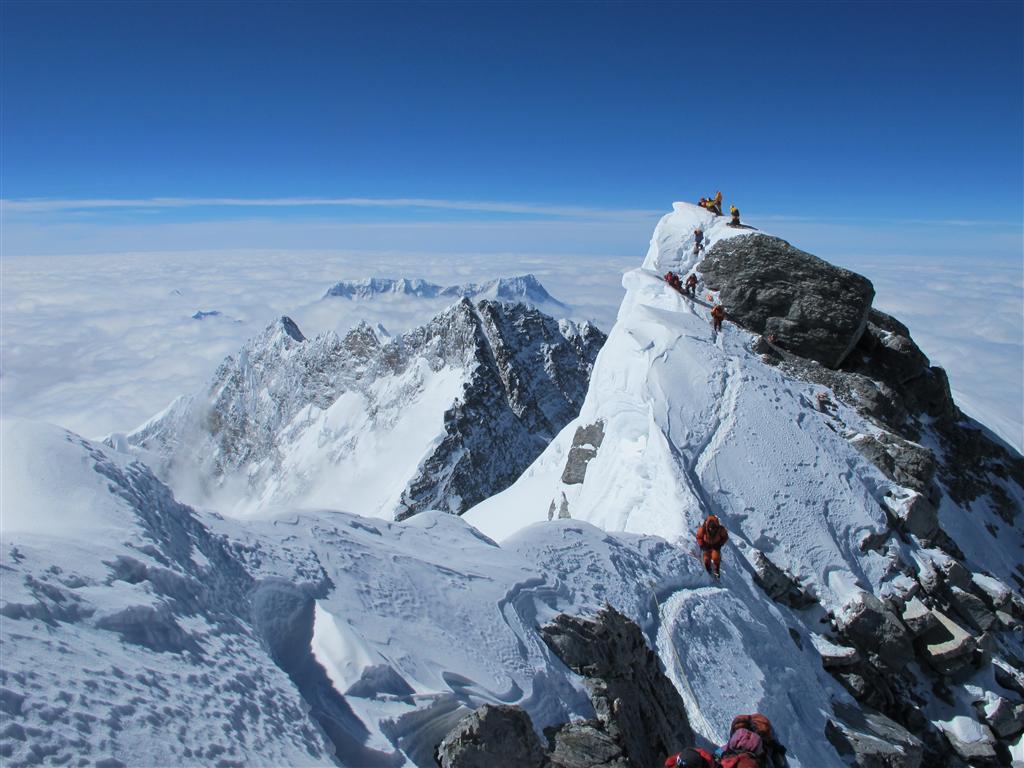
Everest 2016 was a success by many measures. Climbers
achieved life long dreams and a country got a break. It was a "normal'
season with 648 summits in the Spring of 2016, 446 on the south
and 202 on the north. 5 confirmed deaths plus one on Lhotse.
However in stark contrast to the previous four years
on Everest, 2016 lacked large scale tragedy or extreme drama.
Continue
reading about Everest 2016 |
Everest 2017 Coverage

This is one of the more difficult seasons I have covered to sum
up in one word so let me use several: wind, tragedy, misinformation,
spin and summits.
Overall it was a good year, a normal year with many summits on
both sides plus the average death toll. I think we saw how the
pressure to be first with news can backfire with incorrect stories
but we also saw the power of dreams.
Similar to 2016, there were no natural disasters or issues with
people getting along, other than a few individuals acting very
irresponsibly and selfishly.
While weather forecasting proved to be challenging across the
entire two month season, it was not an inhibitor to teams reaching
the summit.
Finally the fear of overcrowding, dangers of the Khumbu Icefall
or China closing Everest forever, proved unfounded.
Bottom line - it was good year on Everest and for both Nepal and
China, and for hundreds who quenched a long thirst to stand on
the summit of Mt. Everest.
In 2017 there were 648 summits, 237 from Tibet and 411 from Nepal
and 11 didn't use supplemental oxygen. There were 6 deaths, 3 didn't
use Os and only 1 died on the descent.
Continue
reading about Everest 2017 |
Everest 2018 Coverage
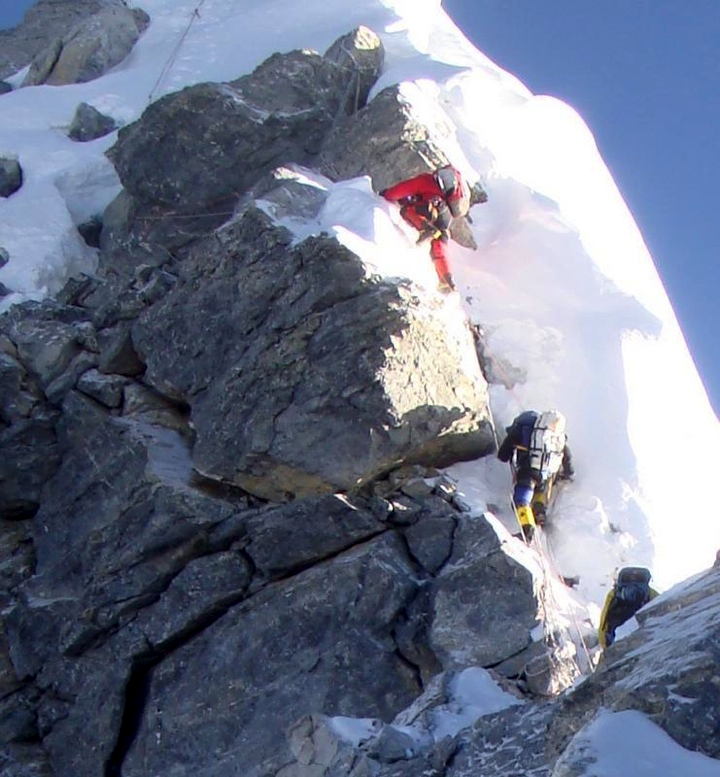
Early in May, there was talk of early summits but then the jet
stream moved on top of Everest and stopped all activity for a
week. When a large high-pressure system parked on the summit,
the door was opened and stayed that way for 11 straight days.
The first summits were on May 14 by the rope fixing
team on the Nepal side followed the next day by 70-year-old Chinese
double-amputee Xia Boya with his Sherpa guides. Every day thereafter
had summits from both the sides. Overall it was about as good
of a season as could be expected on the world's highest peak.
The temperatures were bit warmer than usual and the
winds were calmer in spite of the occasional "difficult" summit
day. With the long weather window, teams spread out thus reducing
the usual crowding we've seen before. In 2012 there were less than
five suitable summit days forcing hundreds to attempt the peak
on the same day.
2018 was a record year for Everest summits. The previous
record year was 2013 with 670 total summits by all routes. The
Himalayan Database has updates for 2018. There were 802 summits
and only 1 who did not use supplemental oxygen and 68 females.
The Nepal side saw a total of 562 summits made up up 266 foreigners
(aka members) and 296 High Altitude Workers (aka Sherpas). For
the members who got above base camp, 76% went on to summit. On
the Tibet (aka Chinese) side there were 110 summits for workers
and 130 by foreigners for a total of 240 summits. 66% of the members
above base camp summited. There were a total of 5 deaths in spring
2018, 4 on the Nepal side and 1 on the Tibet side. 1 climbing was
climbing without supplemental oxygen and was on the south side.
Continue
reading about Everest 2018
|
Everest 2019 Coverage
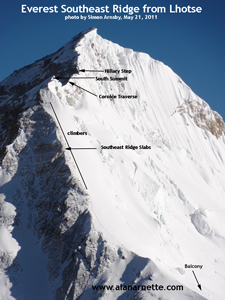
There were approximately 871 summits on Everest in
the Spring of 2019 plus 11 deaths. All-time number of people who
summited Everest is now 10,155, including multiple summits in one
season by one person, and 306 for total deaths. Still, Everest
is one of the safest 8000ers.
2019 was all about the weather. The notorious jet stream was "wobbly" in
the words of Chris Tomer of Tomer Weather Solutions. It colluded
with Cyclone Fani to delay the ropes reaching the summit.
On the Nepal side, the ropes finally made the top due to some
incredible efforts by a team of Sherpas. Beginning on May 22, hundreds
summited early each morning for several days and once again death
was in the air.On May 23, a shocking photo of a line of climbers
on the Hillary Step went viral showing everything bad about Everest.
The root cause of the lines were slow climbers with guides who
failed to properly manage their clients.
How 2019 unfolded was predictable. In 2018, Everest hosted a record
802 people on her summit from both sides. The death toll was five,
about the same each year for the past 10 or so. They died from
what people usually die from on 8000-meter mountains: altitude
sickness, exhaustion, health issues, and the occasional fall. All
tragic, but all somewhat expected. But in 2019 with 11 deaths,
over half were what I term "avoidable."
I've been writing about two major trends that have been rising
and reached a crescendo in 2019: inexperienced climbers and unqualified
guides. These two factors along with a "wobbly" jet
stream and record 381 foreigner permits issued by Nepal conspired
to create a deadly combination of independent factors during the
peak of a truncated weather window in late May.
Six months after the spring season, the biggest question is what,
if anything, will Nepal do about the crowds, the experience of
the climbers and the qualifications of the guides. While there
are solutions I'm not optimistic anything will change. For more
details, please see my complete summary.
Continue
reading about Everest 2019
|
Everest 2020 Coverage

Both China and Nepal closed Everest due to the COVID-19
virus in 2020. However, China allowed a national team and a survey
team to climb to celebrate the 60th anniversary of the first Northside
summit by a Chinese/Tibetan team.
There were 51 summits this spring, all Northside:
8 Tibetans rope fixers, 8 Chinese survey team and 14 Chinese nationals
supported by 21 Tibetans. Congrats to all. These were the latest
summits in decades due to deep snow. New altitude measurement expected
in a few months.
I did a "Virtual" season coverage where
I created a fictional team of climbers. All but one summited:)
Also, we raised money through eight guide companies around the
world on behalf of the Climbing Sherpas who lost significant income
by not working this spring.
Continue
reading about Virtual Everest 2020
|
Everest 2021 Coverage

The spring 2021season on Everest was perhaps the most complicated
in history. With COVID out of control in India and then to Nepal,
it didn't take long for it to reach Everest Base Camp, in spite
of the governments adamant denials and cover ups. Also participating
in this scandal were some guides who feared punishment for spreading "bad
news", a tarnished reputation for not taking care, or simple
greed to ensure future business - we'll never know.
China closed Tibet to all foreigners but allowed one national
team to climb, but they cancelled a few weeks in citing fear of
getting COVID from the Nepal side climbers on the summit - laughable.
The Nepal government issued a record 408 permits to foreigners
but only an estimated 195 members summited, 47%, compared to 76%
in 2019. An estimated 150 people were evacuated from Everest Base
Camp with COVID symptoms. An astounding 339 Sherpa summited, continuing
the trend of Sherpa dwarfing foreigners for Everest summits. Two
members and three Sherpa died this spring, on the low-end of the
usual death count on Everest. We need to wait for the Himalayan
Database to tally the final numbers.
I expect 2022 to be a record year on everest with price increases
across the board. There was little learned from the 2021 season.
Continue
reading about Everest 2021
|
Everest 2022 Coverage

2022 brought even more stable weather windows than during the great
Everest 2018. During May, a stalled high-pressure system made
for horrendous temperatures in Northern India while paradoxically
creating nearly ideal climbing conditions across much, but not
all, of the Himalayas.
In 2022 there were 683 summits, including only 12 from Tibet
as it was closed but 671 from Nepal and all but 5 used supplemental
oxygen. Unlike previous seasons, this spring saw more experienced
climbers resulting in fewer deaths, rescues, and an overall low-drama
environment. Despite this good news, there were periods of brutal
weather and climbing conditions, and yes, there were rescues, close-calls,
and, sadly,3 deaths.
This season, we saw the continued trend of a very high member-to-support
ratio. A milestone reached with more Sherpas summiting than foreigners
in total since Everest climbing began in the 1920s. We'll dig into
this later. All in all, it was a year like we saw a decade ago.
But, unfortunately, it was not without deaths, three deaths on
Everest and three more on the other 8000ers.
In the good news department, for the first time in many years,
the Nepal Ministry of Tourism seemed content to stay out of the
way and the headlines. But, this spring, significant changes appeared
in the world of mountaineering. These changes will disrupt decades
of climbing norms on the 8000-meter peaks.
Continue
reading about Everest 2022
|
Everest 2023 Coverage

The 2023 Everest spring season ended with some records to
take pride in and others to be avoided. If there were one word
to summarize the season, it would be chaotic or perhaps deadly.
This spring was the deadliest season in history on Everest. It
was also brutally cold.
There were around 665 summits on the Nepal side and 12 from Tibet
which was still closed to foreigners. There were a record 18 deaths
- 5 Sherpas and 12 clients. In my estimation, five were preventable.
Nepal issued a record 478 climbing permits to foreigners. Add
in one and a half Sherpa supporting each foreigner; over 1,200
people pursued the summit this spring. Fears were rampant of a
2019 repeat with long lines and deaths. The lines never developed,
thanks in part to colder weather that sent a higher number of climbers
home in mid-season, many with a persistent virus. However, the
deaths developed, but not because of the record permits or climate
change. These are red herrings to abdicate responsibility.
About 667 reached the summit, about 50% of the total permits
with support. Once again, more Sherpas, 378, summited than clients,
277, according to the Himalayan Database.
What stole the headlines were the seemingly daily reports of rescues,
frostbite, missing climber, and deaths. The root cause of the chaos
is still elusive. Some blame the record permit numbers, inexperienced
clients, and low-cost operators. However, Nepal government officials
cite climate change.
Continue
reading about Everest 2023 |
Everest 2024 Coverage

I suspect 2024 will be another busy year. First, there is the
insatiable lure of Everest, and, as is the standard since 2013,
droves of inexperienced climbers drawn by "no-experienced
required" low-cost operators. However, 2024 will be different,
with the north side open to foreigners and the last year before
Nepal raises permit pricing by 36%.
I expect 800 total summits from both sides this spring. Look for
at least 150 Tibet-side total (members plus hired) summits and
well over 650 on the Nepal side. With these numbers, they will
still lag behind the pre-pandemic record set in 2019 of 877 total
summits, comprising 661 from Nepal and 216 from Tibet. Last year,
2023, saw 655 total summits from Nepal and thirteen on Tibet. Let's
break all of this down and what our climbers can expect.
Continue
reading about Everest 2024 |
Northeast Ridge Route Map
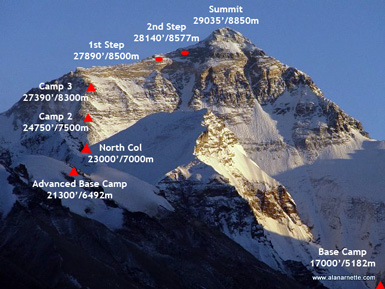
The north side of Everest is steeped in history with multiple
attempts throughout the 1920's and 1930's. The first attempt was
by a British team in 1922. They reached 27,300' before turning
back and was the first team to use supplemental oxygen. It was
also on this expedition that the first deaths were reported when
an avalanche killed seven Sherpas.
The 1924 British expedition with George Mallory and Andrew Irvine
is most notable for the mystery of whether they summited or not.
Mallory's body was found in 1999 but there no proof that he died
going up or coming down.
It was a Chinese team who made the first summit from Tibet on
May 25, 1960 by Nawang Gombu (Tibetan) and Chinese Chu Yin-Hau
and Wang Fu-zhou who is said to have climbed the Second Step in
his sock feet however without a summit photo, some doubt the summit
claim. In 1975, a second summit was climbed by the Chinese and
the ladder on the Second Step was installed.
Tibet was closed to foreigners from 1950 to 1980 preventing any
further attempts until a Japanese team summited in 1980 via the
Hornbein Couloir on the North Face. The north side started to attract
more climbers in the mid 1990s and today is almost as popular as
the South side when the Chinese allow permits. In 2008 and 2009,
obtaining a permit was difficult thus preventing many expeditions
from attempting any route from Tibet.
Read more details on the Northeast
Ridge Route |
South Col Route Map
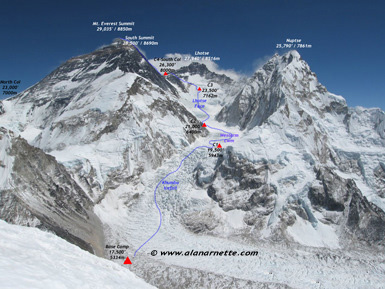
Mt. Everest was first summited by Sherpa Tenzing Norgay and Edmund
Hillary with a British expedition in 1953. They took the South
Col route which is described on this page. At that time the route
had only been attempted twice by Swiss teams in the spring and
autumn of 1952. They reached 8500m well above the South Col. Of
note, Norgay was with the Swiss thus giving him the experience
he used on the British expedition. The Swiss return in 1956 to
make the second summit of Everest. Nepal was closed to foreigners
until 1950.
Today, hundreds of climbers from around the world
use this route to try to stand on top of the world. It is considered
slightly more dangerous than the North Ridge Route due primarily
to the instability of the Khumbu Icefall. However some considered
it slightly easier than the north due to the absence of the ladders
and rock climbing on the steep steps of the North Ridge route.
Read more details
on the South Col Route |
Everest Stats*
Summits - updated January 2024
Early Attempts and Summits
- The first attempt was in 1921 by a British expedition from
the north (Tibet) side
- The first summit was on May 29, 1953 by Sir Edmund Hillary
from New Zealand and Tenzing Norgay, a Sherpa from Nepal. They
climbed from the south side on a British expedition led by Colonel
John Hunt.
- The first north side summit was on May 25, 1960 by Nawang Gombu
(Tibetan) and Chinese climbers Chu Yin-Hau and Wang Fu-zhou
- The youngest person to summit was American Jordan Romero, age
13 years 11 months, on May 23, 2010 from the north side.
- The oldest person to summit was Japanese Miura Yiuchiro, age
80 on May 23, 2013
- The first climbers to summit Everest without bottled oxygen
were Italian Reinhold Messner with Peter Habler in 1978
- Reinhold Messner is the only person to have truly summited
Everest solo and without supplemental oxygen. He did it in 1980
from the Tibet side via the Great Couloir
Male Summits
- The youngest male to summit was American Jordan Romero, age
13 years 10 months, on May 23, 2010 from the north side.
- The oldest male to summit was Japanese Miura Yiuchiro, age
80 on May 23, 2013
- Kami Rita (Topke) Sherpa (Thami) holds the record for most
summits (male or female) with 29, the most recent one in May,
2023.
- Pasang Dawa Sherpa of Pangboche has summited 27 times with
the last on May, 2023.
- Apa Sherpa (Thami Og), Phurba Tashi Sherpa (Khumjung) are next
with 21 summits each. Both are now retired.
- Briton Kenton Cool have the most non-Sherpa summits with 17,
the most recent in 2023.
Female Summits
- The first woman to summit Everest was Junko Tabei of Japan
in 1975
- The oldest woman to summit was Japanese Tamae Watanabe, age
73, in 2012 from the north
- The youngest woman to summit was Indian Malavath Poorna, 13
years 11 months on May 25, 2014 from the north side
- 883 women have summited through December 2022
- Nepali, Lakpa Sherpani, 48, holds the women's summit record
with ten (3 South, 7 north)
Summit Statistics - Through January 2024
- There have been 11,996 summits of Everest through January 2024,
on all routes by 6,664 different people.
- 5,899 members (clients) have summited and 6,097 hired (Sherpas)
- 883 females have summited.
- 1,571 people, have summited multiple
times
- The Nepal side is more popular with 7,695 summits compared
to 3,646 summits from the Tibet side
- 224 climbers summited without supplemental oxygen through January
2043, about 1.9%
- 35 climbers have traversed from one side to the other.
- 681 climbers have summited from both Nepal and Tibet
- 155 climbers have summited more than once in a single season,
including 78 who summited within seven days of their first summit
that season.
- About 62% of all expeditions put at least one member on the
summit
- Member climbers from the USA have the most country member summits
at 906
- Sherpas have the most summits at 6,097
Death Statistics
- 327 people have died on Everest from 1922 to January 2024.
This is about 2.7% of those who summited or a death rate of 1.11
of those who attempted to make the summit.
- 199 westerners and 110 Sherpas have died on Everest from 1922
to January 2024.
- Westerners die at a higher rate, 1.38 compared to hired at
0.87.
- Of the deaths, 178 died attempting to summit without using
supplemental oxygen.
- 14 women have died with death rate of 0.81 compared to 1.14
for male climbers.
- Of the 327 deaths, 92 died on the descent from their summit
bid or 2.8%
- The Nepalese side has seen 8,350 summits with 217 deaths through
January 2024 or 2.8%, a rate of 1.14. 130, or X% of the deaths
not use Os.
- The Tibet side has seen 3,646 summits with 110 deaths through
January 2024 or 3.0%, a rate of 1.11. 48 died not using Os.
- Climbers from the UK and Japan have the most all-time deaths
at 17
- Most bodies all are still on the mountain but China has removed
many bodies from sight.
- The top causes of death on both sides were from avalanche (77),
fall (75), altitude sickness (45) and exposure (26).
- From 1922 to 1999: 170 people died on Everest with 1,170 summits
or 14.5%. But the deaths drastically declined from 2000 to 2023
with 10,826 summits and 157 deaths or 1.4%.
- However, four years skewed the deaths rates with 17 in 2014,
14 in 2015, 11 in 2019 and the record 18 in 2023.
- At least 11 of the 2023 deaths were preventable through better
logistics, adequate oxygen and better on-mountain support.
- The reduction in deaths is primarily due to better higher levels
of Sherpa support, supplemental oxygen at higher rates, better
gear, weather forecasting and more people climbing with commercial
operations.
Latest: Spring 2023
- In 2023 there were 667 summits, including only 12 from Tibet
as it was closed
- 3 did not use supplemental oxygen.
- A record 18 Everest climbers died
- 57% of all attempts by members were successful.
- 61 Females summited.
See more stats at this page
*courtesy of the Himalayan
Database and my own research. |
Everest Resources
Based on my own experiences, I worked on these skills before attempting
Everest:
- Gained climbing experience to be as self sufficient as
possible. All the climbing techniques and skills should be in
your muscle memory and not a conscious thought
- Preparing my body to be in “Everest Shape” which
is beyond "the best shape of your life"
- Building mental toughness to push yourself while being
willing to turn back for safety
CLIMBING SKILLS - knots and roped team travel
- crampon skills - ice axe skills including self arrest in all
types of positions - crevasse rescue techniques
CAMPING SKILLS - extreme cold weather clothing
techniques - packing what you need; not what you want
PHYSICAL TRAINING - stamina, cardio, strength,
breathing techniques - understanding how your body performs at
altitude preferably at 8000m before going to Everest
MENTAL TRAINING - getting along in close quarters
with strangers for 2 months, teamwork
These pages are based on my own experiences:
1. Everest Frequently asked
questions and 8000
meter mountains Frequently Asked Questions
2. Skills and Experience
3. Training and Fitness
4. Everest Gear
5. Guides
6. South Side Route
Overview
7. North Side Route
Overview
8. A
description of my first Everest South Climb in 2002
9. A full report of my Everest
South Summit in 2011
Preparing for a Climb is More Than Training
Schedule
a Free Call
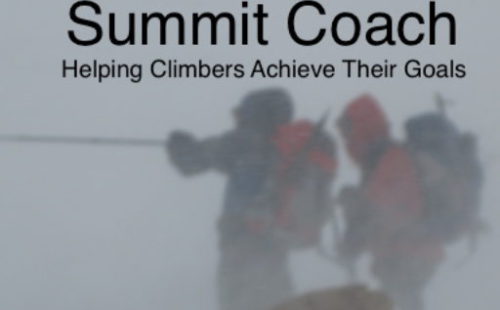
If you dream of climbing mountains but are unsure
how to start or to reach your next level from a Colorado 14er
to Rainier, Everest or even K2 we can help. Summit
Coach is a consulting service that helps aspiring climbers
worldwide their goals through a personalized set of consulting
services based on Alan Arnette’s 27 years of high altitude
mountain experience and 30 years as a business executive. Please
see our prices and services on the Summit
Coach website.
|
|

